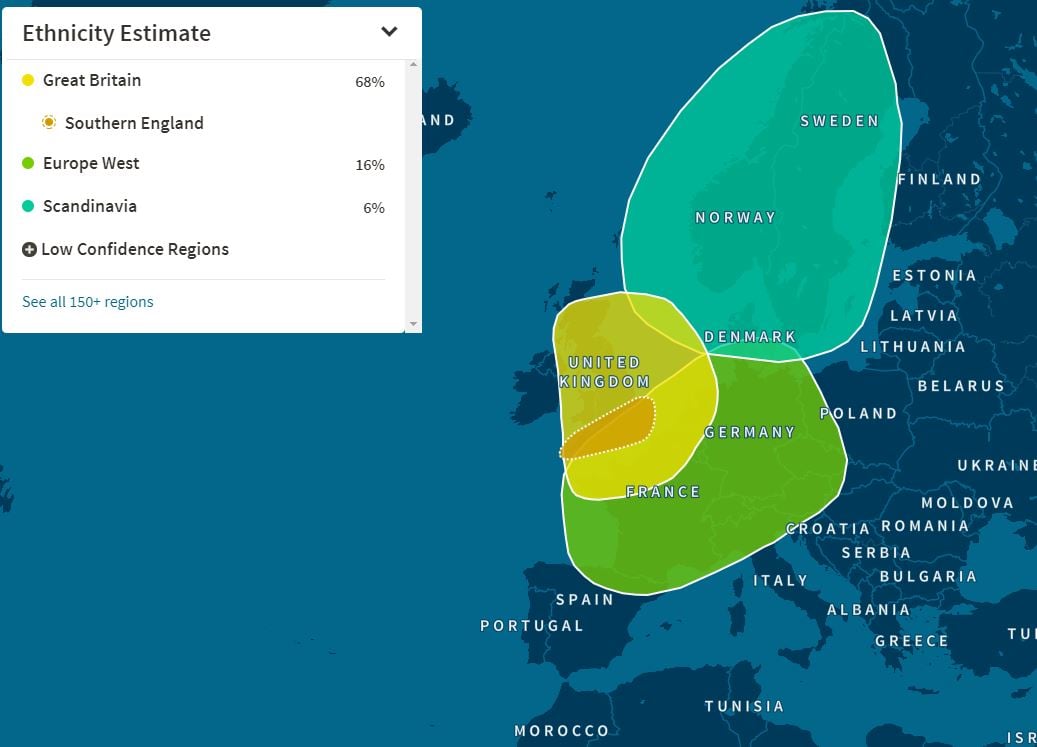NPEs and genealogical mistakes (particularly over six generations ago) are possible. However, bearing in mind the above factors, I feel that I have a reasonably good documented record to compare DNA-tests-for-ancestry against.
The two tests in the table below, are my son Edward (left), and myself (right). We are both British by nationality and English by ethnicity. We live in East Anglia, home of many of our documented ancestors. I am mainly of East Anglian ancestry, but with some Oxfordshire, Berkshire, Northants, and Swiss lines. Edward's mother by ancestry is half English (Berks, Wilts, East Anglia, Beds, Somerset) and half Irish.
The "actual documented ancestry" are percentages divided into LDNA sub regions, based on Generation 6 (32 x 3rd great grandparents) with some references to Generation 7 when noteworthy.
Discussion.
Living DNA has made great commercial headway through the use of the POBI dataset, that had been acclaimed by the original team, as demonstrating a distinguishable pattern that aligned well with the Anglo-Saxon period British kingdoms. The reference samples were well chosen, with geographically local born grandparents, and a bias to rural testers over urban (that see more mobility). However, LDNA, we know, have made lot's of alterations with their sub regions.
In both the case of Edward's and my documented East Anglian ancestry, the LDNA saw less than 50% of what I'd expect. I believe that some of our EA went elsewhere - Lincs, SE England, Germanic, Scandinavian, etc.
Edward got a big chunk of Lincs and SE England that I just do not think is real.
I got 10% Tuscan that I don't believe. Something could however correlate to a Swiss 3 x great grandparent. But that percentage? I know it is possible. Edward got no Tuscany.
Edward, with his 25% actual Irish ancestry received 98% GB & Ireland. His father, myself, although 97% actual, received only 70% GB & Ireland. I think that rather like with other test companies - Ireland, Scotland, and Wales look more "British" than do the English on tests. Yet Edward only received a mere 2% Irish on the test! That is an even more serious underscore.
Before I tested with Living DNA, I really was starting to lose faith in autosomal DNA testing for general ancestry. When Living DNA launched, my hopes were raised that with the right references, computing power, and chips, that one day, they could be much more accurate and meaningful than they have been up to now.
After Edward's results, I'm starting to lose a bit of faith again. I feel that these tests are good for pin pointing a corner of Europe at best. Beyond that, there may be average PCA plots, but they are far too fuzzy to base "ancestry composition", my origins", or "ethnicity estimate" percentages on with any degree of certainty or accuracy. Fun yes. Useful to build a personal DNA "ancestral population flavour and PCA plot" yes. But that's all. Beyond that is a roll of the dice. Too many testers take their results far too literally. Too many testers also display brand loyalty.
As for haplogroups, Edward's results were disappointingly basic.
Y-DNA L1
mtDNA H (only 4 mutations listed on the csv file).




















